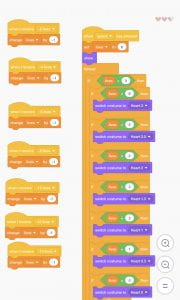During this project, I have learned a very important lesson… matter matters.
These past few weeks, we have discussed in class the Kinetic Molecular theory and the Atomic theory. Our goal was to show our knowledge by coding a Scratch game or simulator that answers our driving question:
How can the behaviour of matter be explained by the Kinetic Molecular theory and the Atomic theory?
As per usual, we started off this project by creating a mind map using Mindnode to organize our thoughts, questions, and ideas. Upon completion of this project, we revised our mind maps to display our knowledge.
In short, the Kinetic Molecular theory describes the behaviour of matter. This theory explains how all particles are constantly moving and therefore have kinetic energy. Temperature also affects how much kinetic energy there is in a substance.
Here are examples of the behaviour of matter:
- Typically, particles in a solid object are very close together. These particles don’t move around, but they do vibrate.
- Particles in a liquid are somewhat close together, but not as close as the particles in a solid. These particles also slip and slide past one another, albeit not as quickly as the particles in a gas.
- Furthermore, particles in a gas are very far apart, and move with speed.
On the other hand, the Atomic theory explains that matter is composed of small particles known as atoms. Over time, there have been multiple variations of the Atomic theory. Although Dalton’s theory is most accepted theory today, scientists have since discovered that atoms aren’t the smallest particles out there. Atoms consist of other particles such as protons, neutrons, and electrons.
Once we were ready with the knowledge necessary in order to code our Scratch creation, we were to come up with a programming plan. You can see mine above.
Afterwards, I finally got started on my Scratch game. As mentioned in my plan above, I wanted to create a guessing game or trivia game of some sort. Each question would be based off of the kinetic molecular theory or atomic theory. This is how I decided to answer the driving question.
 Here is a cactus drawing I made to use as my gameshow host. His name is Monsieur Ukki, and he’s a French cactus.
Here is a cactus drawing I made to use as my gameshow host. His name is Monsieur Ukki, and he’s a French cactus.
 Although I won’t show all of my coding, here is the code I used for the “lives” in my game. If you want to check out my entire code, feel free to click the link to my project!
Although I won’t show all of my coding, here is the code I used for the “lives” in my game. If you want to check out my entire code, feel free to click the link to my project!
Curricular Competencies:
- Questioning and predicting: Demonstrate a sustained curiousity about a scientific topic or problem of personal interest.
This competency represented our desire to learn and discipline to remain on task. I did have difficulties at times, but I feel that I did well on this competency. My friend, Ava, and I also spent time helping each other with our Scratch codes during class. Thanks for that!
- Scientific communication: communicate ideas, findings, and solutions to problems using scientific language, representations, and digital technologies.
This competency represented the more scientific aspects of our project. I feel that I did well on including a variety of atomic models, states of matter, and particle motion. However, I did have to revise and add the particle motion since I hadn’t done so on my original version of my game.
- Reasoning and analyzing: Use logic and patterns (including coding) to solve puzzles and play games.
This competency represented the more technical aspects of our project, such as the code we used for our Scratch games/simulators. I coded my game to be interactive with whomever is playing it. In order to beat the game, the player must answer each question correctly, albeit with a limited number of lives.
In conclusion, the Kinetic Molecular theory and Atomic theory affect our daily lives. From the dew on the morning grass, the steam on the bathroom mirror, or even the feeling of soil beneath our feet. Changes are happening to matter everywhere around us, and that’s what makes it important for us to learn about them.
If we choose to ignore what’s right in front of our eyes, how can we ever learn?



May 12, 2021 at 11:10 am
Congratulations! NICE WORK & it’s a fun game 👌
May 12, 2021 at 3:10 pm
Thank you!